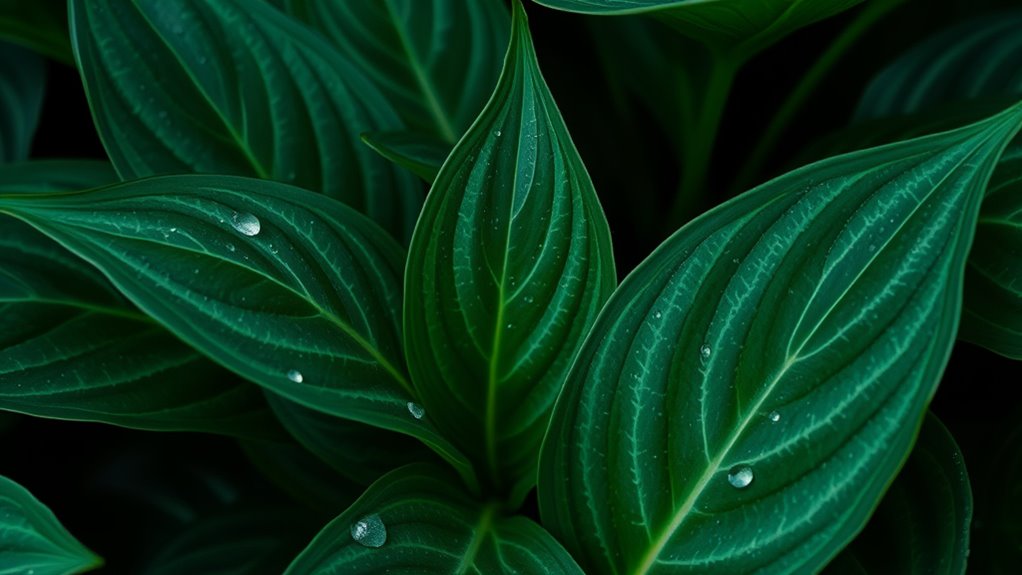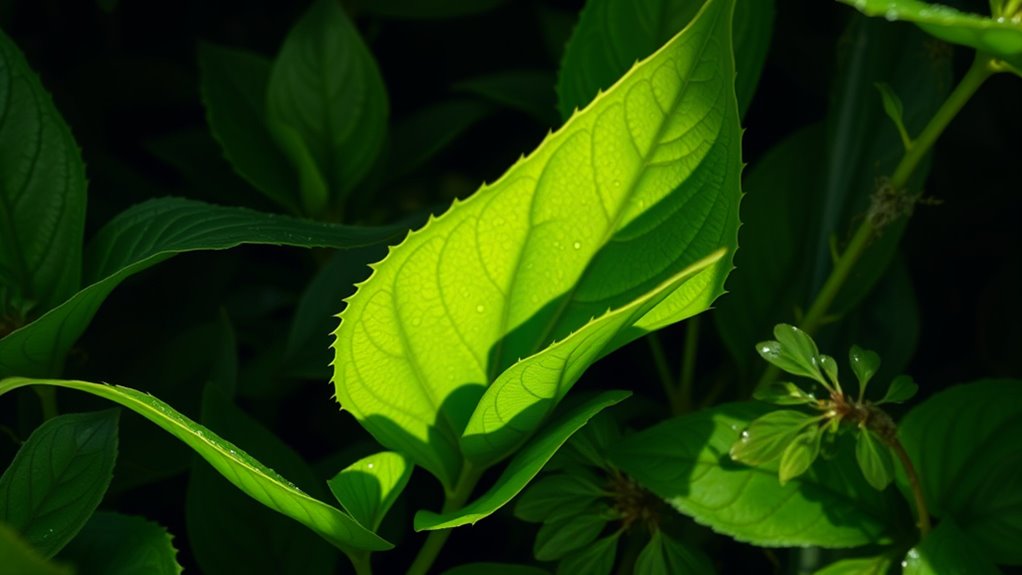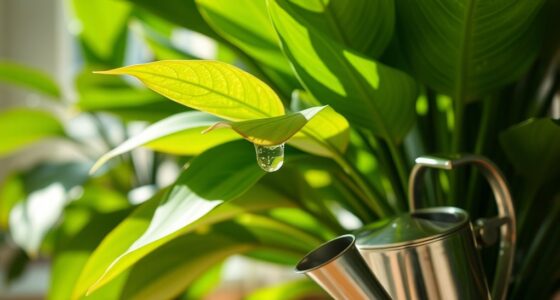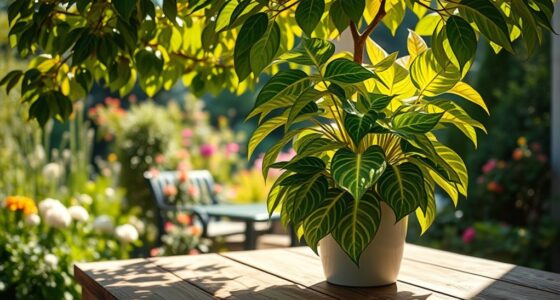Low-light plants are true legends for shaded spaces, thriving with minimal sunlight and forgiving neglect. You can turn dull corners into vibrant green retreats by choosing popular varieties like snake plants, pothos, and peace lilies, which require little watering and are easy to care for. Their ability to survive in low light makes them perfect for offices, bedrooms, or dim corners. Keep exploring to uncover more tips on creating lush indoor environments with these resilient greens.
Key Takeaways
- Many plants labeled as low-light actually need some indirect or minimal light to thrive.
- Snake plants, pothos, and peace lilies are reliable low-light plants that tolerate shade well.
- These plants require less frequent watering, making them forgiving choices for shaded indoor spaces.
- Low-light plants enhance décor, improve air quality, and turn dull corners into lush green spots.
- Proper placement in shaded areas, like behind furniture or near north-facing windows, is key to their success.

Many indoor spaces receive limited natural light, but that doesn’t mean you can’t enjoy the greenery. Low-light plants are perfect for transforming dim corners or shaded areas into lush, vibrant escapes. These plants have adapted to thrive in shade, making them ideal for offices, bedrooms, or rooms with small windows. By choosing the right varieties, you can bring life to spaces that otherwise seem dull or unused.
Transform dull corners into lush green retreats with easy-care low-light plants.
You’ll find that many low-light plants are surprisingly easy to care for. They typically require less frequent watering because they don’t undergo rapid growth, which reduces the risk of overwatering and root rot. Their leaves often have darker, broader surfaces, which help them capture even minimal light more efficiently. For example, the snake plant, also known as mother-in-law’s tongue, tolerates neglect and low light conditions exceptionally well. It can survive in nearly dark corners and only needs watering every few weeks. Similarly, pothos plants are highly adaptable and can grow in low-light settings, often trailing from shelves or hanging baskets, adding a touch of green without demanding much attention.
Many of these plants also have the advantage of being forgiving if you forget to water them occasionally. Their resilience makes them perfect for busy or forgetful plant lovers. The peace lily is another popular choice; it can tolerate low light and also helps improve air quality. Its elegant white flowers bring a touch of sophistication to any space, and it’s known for being forgiving if you miss a watering or two.
In addition to their practicality, low-light plants can add texture and depth to your décor. Their varied leaf shapes and shades of green create visual interest even in the darkest rooms. They can be grouped together to form a small indoor jungle, or placed individually in decorative pots to highlight their unique features. Since they don’t need direct sunlight, you can position them in shaded nooks, behind furniture, or near north-facing windows without worry.
In essence, low-light plants are your best allies if you want to cultivate greenery in spaces that don’t receive much sunlight. They require minimal fuss, are highly adaptable, and can turn even the dullest corners into vibrant, lively spots. With a little knowledge and care, you’ll discover that thriving greenery is within your reach, regardless of how limited the natural light may be.
Frequently Asked Questions
Do Low-Light Plants Require Less Watering Than Sun-Loving Plants?
Yes, low-light plants generally need less watering than sun-loving plants because they tend to grow more slowly and use water more efficiently. However, you should still check the soil regularly; if it feels dry, water your shade-loving plants. Overwatering can lead to root rot, so it’s important to strike a balance. Adjust your watering routine based on your plant’s specific needs and the humidity levels in your home.
Can Low-Light Plants Improve Indoor Air Quality Effectively?
Yes, low-light plants can improve indoor air quality effectively. You’ll notice better air circulation and fewer pollutants when you include plants like pothos or snake plants in your space. They absorb toxins and release oxygen, making your environment healthier. To maximize benefits, guarantee you care for them properly, water them appropriately, and keep their leaves clean. This way, you create a fresher, more inviting atmosphere in your home or office.
Are Low-Light Plants Suitable for Outdoor Shaded Gardens?
Imagine you’re a Victorian gardener—yes, Victorian! Low-light plants are perfect for outdoor shaded gardens. They thrive under trees or structures blocking direct sunlight. You’ll find many options like ferns, hostas, and shade-tolerant grasses that flourish without much fuss. These plants add lush greenery and texture, creating a peaceful retreat. Just make certain you pick varieties suited to your climate and maintain consistent moisture for the best results.
How Often Should I Fertilize Low-Light Plants?
You should fertilize your low-light plants about once a month during the growing season, typically spring and summer. Use a balanced, water-soluble fertilizer diluted to half strength to avoid overfeeding. During fall and winter, reduce fertilization or stop altogether, as growth slows down. Keep an eye on your plants for signs of nutrient deficiency, like pale leaves or stunted growth, and adjust your fertilizing schedule accordingly.
What Are Common Pests That Affect Shade-Loving Plants?
Have you ever wondered what pests might threaten your shade-loving plants? Common culprits include spider mites, aphids, and scale insects. These pests can sap your plants’ energy, causing yellowing or wilting. To protect your plants, regularly inspect them for signs of pests, keep leaves clean, and use natural or chemical treatments as needed. Staying vigilant helps make certain your low-light favorites stay healthy and vibrant.
Conclusion
Think of low-light plants as quiet guardians of your space, thriving in shadows where others falter. Like loyal sentinels, they remind us that strength isn’t always in the spotlight but in resilience and adaptability. Embrace these verdant allies, and you’ll find your indoor jungle flourishing quietly yet fiercely, proving that even in the dimmest corners, life can bloom boldly. Sometimes, the most subtle beings hold the greatest power in transforming our worlds.











